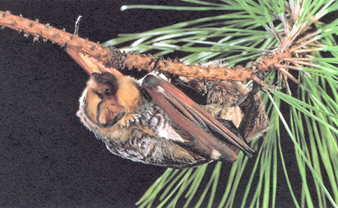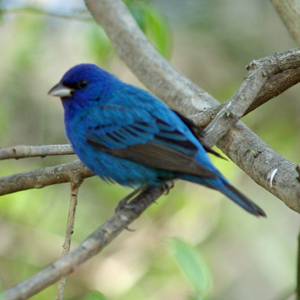Bats of Iowa
Vespertilionidae
Lasiurus cinereus (Palisot de Beauv)
Hoary Bat

Etymology
Greek: Lasiurus - "hairy tail." Latin: cinereus - "ash-colored."
Appearance
Fur: Yellowish to brownish with frosty (hoary) appearance; hair -
broad cream/ tan band, narrow blackish, subterminal band, whitish
tip.
Tail membrane: Completely furred dorsal surface. Wing membrane:
Brownish-black, yellowish along forearm; white patches at elbow and
wrist.
Calcar: Long, narrow keel.
Ears: Relatively short (19 mm); edged with black with whitish
patches; rounded tip.
Tragus: Less than one-half ear length; blunt tip; curved forward.
Other: Whitish wrist and shoulder hair patches: top of feet and ears
furred.
Total length: 130-149 mm. Forearm: 46-58 mm. Wingspan: 380-410 mm ..
Total weight: 15-35 g.
Dental formula: 32 total; I 1/3, C 1/1, P 2/2, M 3/3.
Confusing Species
Silver-haired bat (L. noctivagans): Smaller size «20 g) and shorter
forearm «46 mm); black color; lacks fur on feet, ears and terminal
part of tail membrane; Incisors 2/3.
Red bat (L. borealis): Smaller size «15 g) and shorter forearm «46
mm); reddish color.
Distribution and Status
Overall: North America from central Canada to southern Florida and
Guatemala.
Iowa: Females found statewide in summer; adult males rare except
during migration.
Primarily a solitary resident of the deciduous forests, the hoary
bat is known to roost at least 3-5 m above the ground in dense
foliage of trees and shrubs, sometimes in urban areas. Although it
is the largest of Iowa's bats, this species is rarely encountered by
the casual observer. If found, it is usually a female with young
attached, probably blown or knocked from its tree roost during a
summer windstorm.
Adult males are thought to migrate through Iowa northward or
westward since few have been found here during summer months.
Probably all individuals move southward to overwinter. However, the
large size and thick fur, plus cold weather records elsewhere in the
Midwest, suggest the possibility that a few may spend the winter in
Iowa.
At least some individuals mate during the fall migration, although
details of reproduction are not well known. In Iowa, from one to
four young are born after females return to their summer range, with
birthing occurring from mid-May to early June. The earliest born
young begin to fly by late June.
The hoary bat is a faster, more direct flier than most bats in Iowa
and shows a peak of foraging activity later in the evening. Stomach
analyses indicate a wide variety of insects are eaten including:
beetles, flies, grasshoppers, termites, dragonflies, wasps, moths
and mosquitoes. This species has a statewide distribution and does
not appear to be in danger of extirpation. However, as with any
predominately forest-dwelling bat, continued decline of forest
habitat could seriously decrease its population or restrict its
distribution in Iowa.

.jpg)

